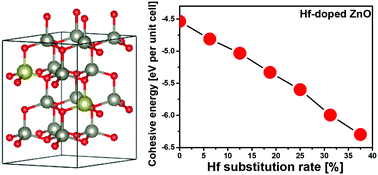Explaining doping in material research (Hf substitution in ZnO films) by directly quantifying the van der Waals force
Abstract
Non-monotonic behavior has been observed in the optoelectronic properties of ZnO thin films as doped with Hf (HZO). Here we propose that two competing mechanisms are responsible for such behaviour. Specifically, we propose that provided two crystal orientations dominate film growth, only one of them might be responsible for direct Hf substitution. Nonmonotonic behaviour is expected at once by considering that preferential growth of the crystal that allows for direct Hf substitution is inhibited by Hf concentration in the manufacturing process. This inhibition would also be a thermodynamic consequence of Hf substitution. Maxima in Hf substitution is thus reached at a point where enough crystals exhibit the preferential orientation, and where enough Hf is present on the surface for substitution. Outside this optimum scenario, Hf substitution can only decrease. We interpret the surface phenomena by discussing surface energy and the van der Waals forces as measured experimentally by means of atomic force microscopy.



 Please wait while we load your content...
Please wait while we load your content...